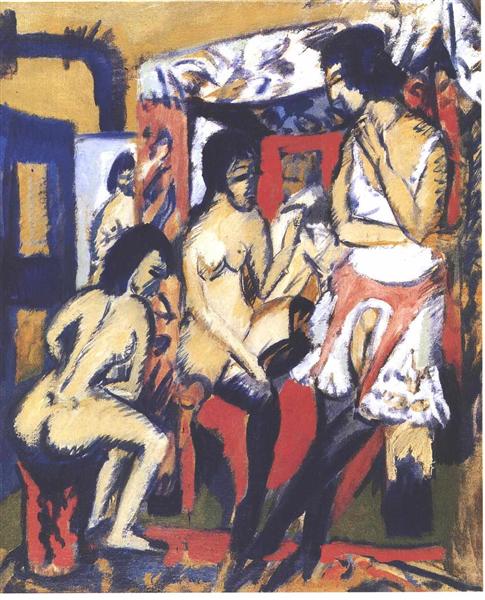Description
The work "Nudes in the workshop" by Ernst Ludwig Kirchner, painted in 1910, represents one of the most significant manifestations of the expressionist aesthetics that characterized this German artist. Kirchner, co -founder of the Die Brücke group, stood out for his ability to capture the psychology of the human figure, as well as the intensity of color and shape. In this painting, the artist evokes both the environment of his study and an atmosphere of intimacy that becomes palpable through his bold compositions and color treatment.
On the canvas, two naked female figures are in a space that suggests being a workshop, an environment that adds a layer of significance in relation to the artistic process. The figures, although represented in a stylized way, seem to communicate with a vital energy that is the center of the dynamics of the work. Kirchner uses strong lines and defined contours that describe their forms in dispossession, emphasizing the almost sculptural character of their bodies. The representation of nudity here is not merely an act of exhibition, but proposes a dialogue between art and nature in a context that moves away from the traditional academic approach to the nude. Kirchner often sought to get away from conventional representation, which allowed him to address the human figure from a more visceral and emotional perspective.
The color in "nudes in the workshop" is undoubtedly one of the most powerful elements of the work. Vibrant tones and marked contrasts not only give life to the figures, but also establish a sense of immediacy and tension. The palette is composed of warm and cold colors that interact almost instinctively, evoking diverse emotions ranging from calm to repressed energy. This vibrant color interaction is characteristic of expressionism, which Kirchner adopted as a means to offer a more subjective and emotional vision of the world.
The arrangement of the figures in space is remarkable. Located intimately but not obvious, there is a kind of complicity between them. Kirchner makes the relationship between the figures an amalgam of connection and distance, which invites the viewer to reflect on the dynamics of the body and female subjectivity. Even when women seem to be absorbed in their own world, their nudity in the context of the workshop suggests broader issues such as vulnerability, intimacy and act of creating. This becomes a testimony of the place occupied by these figures in the artist's own life and in the society of the time.
It is interesting to place "naked in the workshop" within the broader context of Kirchner's artistic production and its relationship with other partners of the expressionist movement. The work can be compared to other nudes of his contemporary Henri Matisse, where the form and color is also explored, but from an perspective that tends more towards harmony and light. While the use of color in Matisse points to an aesthetic balance, Kirchner, in its exercise, displays an emotional and almost aggressive palette that is loaded with dynamism.
Ultimately, "naked in the workshop" it is not only an invitation to enjoy the beauty of the human body, but also moves the viewer to question the established values around the female figure. The work is part of Kirchner's legacy as a pioneer of expressionism, a style that continues to resonate in contemporary art for its ability to evoke deep emotions and for the challenge it presents to social and artistic conventions. The importance of his work lies in his ability to combine the personal with the universal, offering a rich and multifaceted vision of human experience.
KUADROS ©, a famous paint on your wall.
Hand-made oil painting reproductions, with the quality of professional artists and the distinctive seal of KUADROS ©.
Art reproduction service with satisfaction guarantee. If you are not completely satisfied with the replica of your painting, we refund your money 100%.

